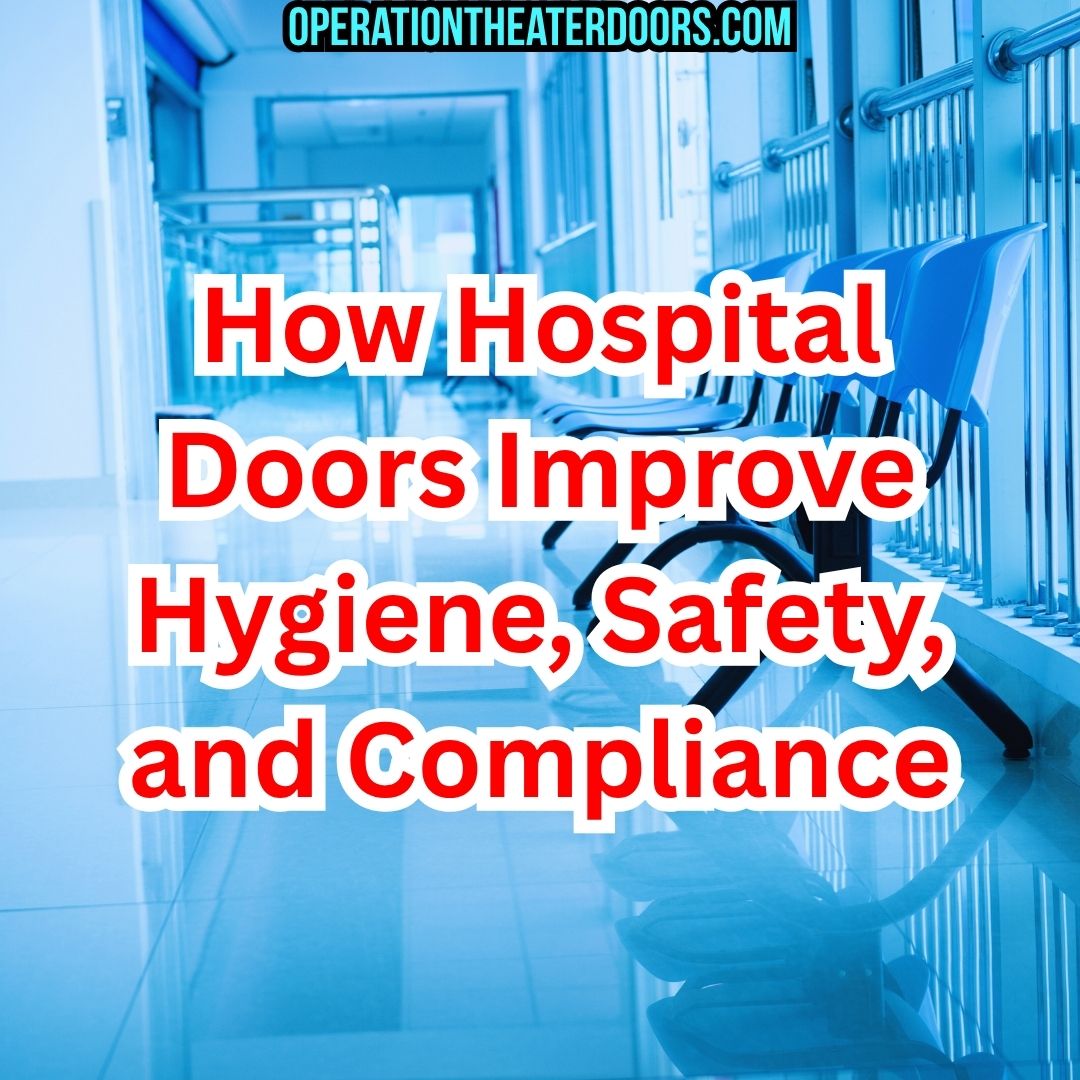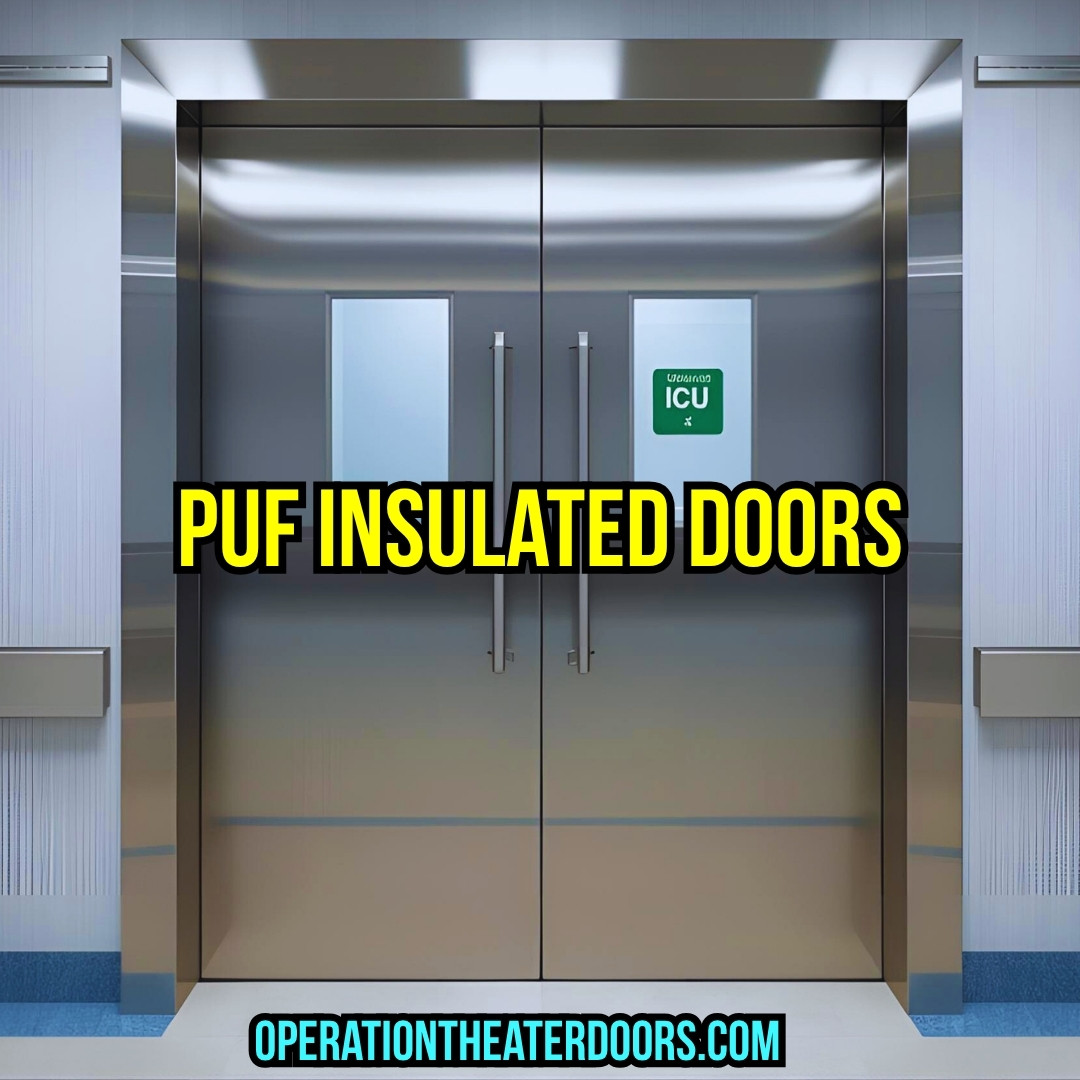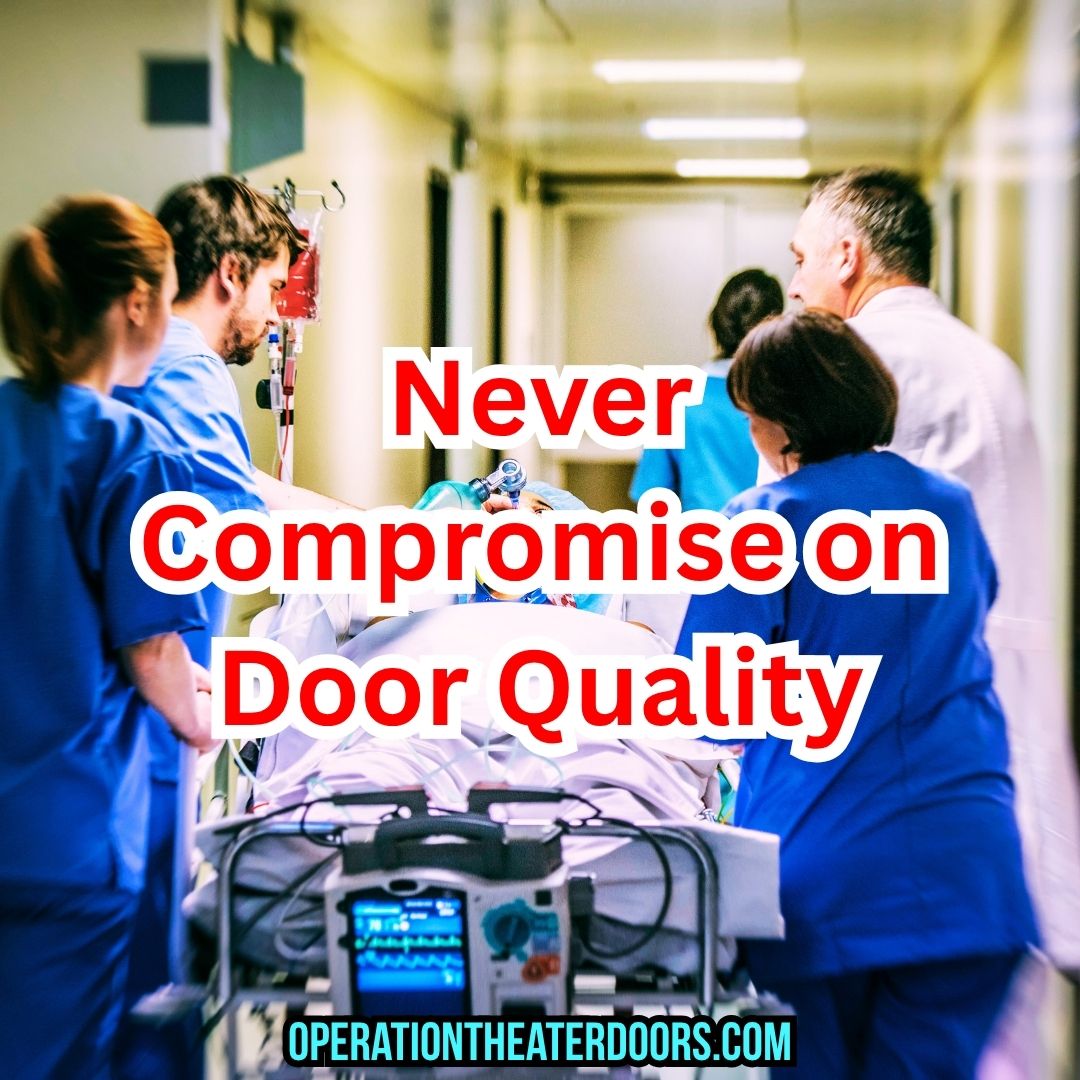
In the bustling healthcare landscape of Ahmedabad and Gujarat, where hospitals and modular operation theatres (OTs) stand as pillars of life-saving care, every detail matters. Imagine a critical patient in an ICU, recovering from a major surgery—vulnerable to the slightest contamination or discomfort. Did you know that hospital-acquired infections (HAIs) affect 10-20% of admitted patients in India, with ICUs reporting an incidence rate of up to 4.4%? These infections, often stemming from airborne particles or poor environmental controls, can extend hospital stays by days or weeks, adding immense strain to both patients and healthcare providers.
As a seasoned expert in healthcare infrastructure, particularly in cleanroom solutions and turnkey projects for pharma cleanrooms, IVF centres, and diagnostic labs, I’ve seen firsthand how the right ICU door can be a silent guardian. An ICU door isn’t just an entry point; it’s a barrier against infections, a regulator of temperature and noise, and a facilitator of swift emergency access. In this comprehensive guide, we’ll explore how to select the ideal ICU door, tailored for Indian hospitals, modular OTs, and beyond—ensuring patient safety and comfort while meeting NABH accreditation demands. Whether you’re a hospital consultant in Gujarat or a plant manager overseeing electronics facilities, these insights will empower your decisions.
The Critical Role of ICU Doors in Modern Healthcare Infrastructure
Let’s start by unpacking why ICU doors deserve such meticulous attention. In high-stakes environments like ICUs, where patients with compromised immunity rely on sterile conditions, doors serve as the frontline defence in infection control. According to the World Health Organization (WHO), effective infection prevention and control (IPC) practices can reduce HAIs by up to 30% in healthcare settings. In India, with over 1.3 million hospital beds and a surge in modular ICU setups post-pandemic, poor door design can lead to costly breaches—financially and clinically.
Consider the anatomy of an ICU: constant movement of staff, equipment, and visitors creates pressure differentials that doors must manage. A subpar ICU door might allow dust-laden air from corridors to infiltrate, harbouring pathogens that cause ventilator-associated pneumonia (VAP)—a leading HAI in Indian ICUs, affecting 16 per 1,000 ventilator days. On the comfort front, noise from adjacent wards or Gujarat’s humid summers can disrupt recovery, elevating stress hormones in patients.
For B2B audiences like pharma QA teams and HVAC contractors, think beyond hospitals. In pharmaceutical cleanrooms or semiconductor units in Ahmedabad, similar principles apply: ICU doors (or their equivalents like cleanroom doors) maintain ISO-classified air quality, preventing cross-contamination in sterile zones. NABH standards, updated in their 6th edition effective January 2025, mandate restricted entry to ICUs, with isolation rooms featuring positive and negative pressure systems—doors being integral to this setup.
In essence, choosing the right ICU door aligns with turnkey projects that integrate HVAC, HEPA filtration, and modular OT designs. It’s not just about compliance; it’s about creating healing spaces that support NABH accreditation and WHO’s core IPC components. For more on seamless ICU setups, explore our ICU Setup services.
Key Factors to Consider When Choosing an ICU Door
Selecting an ICU door isn’t a one-size-fits-all affair. It demands a balanced evaluation of safety, functionality, and longevity, especially in India’s diverse climates—from Gujarat’s scorching heat to monsoon-driven humidity. Let’s break this down into core factors, drawing from real-world applications in hospitals, pharma cleanrooms, and food & beverage units.
Material Durability and Insulation: Prioritizing PUF Insulated Doors
At the heart of any robust ICU door lies its material. Polyurethane Foam (PUF) insulated doors have emerged as a gold standard in Indian healthcare, thanks to their superior thermal properties. PUF panels, with a low thermal conductivity of around 0.02 W/mK, create an airtight barrier that maintains stable room temperatures—crucial for patient comfort in non-air-conditioned backups during power outages common in rural Gujarat setups.
Why PUF? Unlike traditional hollow-core doors, PUF insulated doors reduce heat transfer by up to 75%, slashing energy costs in HVAC-dependent ICUs. In a case from a Ahmedabad-based diagnostic lab, switching to PUF panels cut cooling expenses by 20% while enhancing sound insulation—dampening external noise to below 35 dB, promoting restful recovery. For cleanroom flush doors in pharma facilities, PUF’s non-porous surface resists microbial growth, aligning with GMP standards.
As an ICU door manufacturer, we recommend doors with 40-50mm thick PUF cores, galvanized steel skins, and powder-coated finishes for corrosion resistance. This isn’t fluff—it’s actionable: always verify the R-value (thermal resistance) exceeds 5 m²K/W for Gujarat’s variable weather. Dive deeper into our PUF Insulated Doors for specs tailored to modular OTs.
Sealing and Airflow Control: The Power of Hermetic and Cleanroom Doors
Infection control hinges on containment. Hermetic doors, with their inflatable seals that compress upon closure, achieve near-zero air leakage—vital for negative-pressure isolation rooms in ICUs handling airborne diseases like TB, prevalent in Indian hospitals. NABH requires such features in ICUs to prevent cross-transmission, where a single breach could infect multiple patients.
For pharma cleanrooms and IVF centres, cleanroom doors with flush designs and vision panels (tempered glass for visibility without compromise) ensure ISO 5-8 compliance. These doors integrate seamlessly with HEPA-filtered HVAC, maintaining particle counts below 3,520 per cubic metre. In electronics and semiconductor facilities, where static discharge is a risk, antistatic coatings on cleanroom doors add another layer of safety.
Practical tip: Opt for automatic hermetic ICU doors with sensors for touchless operation—reducing fomite transmission by 40%, per WHO IPC guidelines. In a Gujarat IVF lab retrofit, this upgrade halved contamination incidents, proving ROI in under a year.
Fire Safety and Emergency Compliance: Integrating Fire Exit Doors
No ICU door discussion is complete without fire safety. Fire exit doors, often integrated into ICU designs, must withstand 60-120 minutes of blaze per BIS 3614 standards, with intumescent seals that expand under heat. In crowded urban hospitals like those in Ahmedabad, where evacuation drills are routine, these doors double as emergency exits without compromising airtightness.
NABH’s infection control chapter emphasizes zoned fire safety, linking it to patient safety. PUF insulated doors excel here too—their self-extinguishing foam meets Class B1 fire ratings, unlike cheaper alternatives that warp under 200°C. For warehouse managers in food & beverage units or cold storage, similar fire-rated pharma doors prevent flash fires in controlled environments.
Actionable insight: Pair ICU doors with panic hardware for quick egress, ensuring wheelchair accessibility per CPWD guidelines. Our Fire Exit Doors blend these features for turnkey compliance.
Ease of Access, Maintenance, and Aesthetics: Enhancing Staff Efficiency and Patient Comfort
Comfort extends to usability. Swing or sliding ICU doors with soft-close mechanisms minimize injury risks during high-traffic shifts—essential in 24/7 ICUs. For architects designing modular OTs, consider trackless sliding options that save 40% floor space, accommodating Gujarat’s compact hospital builds.
Maintenance is key: Doors with seamless welds and antimicrobial handles (copper-infused) reduce cleaning time by 30%. Aesthetically, powder-coated finishes in neutral tones blend with hospital palettes, fostering a calming ambiance. In educational & research labs, where student traffic is high, durable hospital doors with reinforced hinges last 20+ years.
For plant managers in cosmetic & chemical plants, low-VOC materials ensure no off-gassing, aligning with green building norms.
Regulatory Compliance: NABH, WHO, and Local Standards
Finally, compliance seals the deal. NABH’s 2025 standards demand ICU doors support hand hygiene stations and 1:1 nurse ratios, with built-in alcohol dispensers. WHO’s IPC framework stresses environmental barriers, recommending doors that facilitate standard precautions like PPE doffing zones.
In India, align with Schedule M for pharma doors and AE(E&S) for hospitals. For turnkey contractors, pre-certified ICU doors expedite audits—saving months in Gujarat’s NABH push.
Exploring Types of ICU Doors for Diverse Healthcare Needs
With factors in mind, let’s survey types suited to Indian contexts—from hospitals & surgical centres to chemical factories.
Sliding and Automatic ICU Doors: For High-Traffic Efficiency
Sliding ICU doors, manual or automatic, dominate modular setups. Infrared sensors enable hands-free entry, cutting infection risks in pathology labs. In a Mumbai hospital (mirroring Ahmedabad trends), automatic versions reduced door-touch contacts by 50%, per internal audits.
Hermetic and Airtight Doors: Sterility Champions in Cleanrooms
Hermetic ICU doors, with vacuum seals, are non-negotiable for isolation. In pharma cleanrooms, they maintain 0.05-0.1 m/s airflow, preventing particulate ingress. For IVF & surgical centres, glass-clad versions offer visibility without seals compromise.
PUF Panel and Flush Doors: Versatile Insulated Solutions
PUF insulated doors, as operation theater door manufacturers emphasize, multitask: insulation for comfort, flush surfaces for wipe-downs. In food & beverage units, they control humidity; in electronics facilities, ESD-safe variants protect sensitive gear.
Specialized Variants: Fire-Rated and Emergency Exit Doors
Hybrid fire exit doors with hermetic seals cater to NABH’s dual mandates. In warehouses, these pharma doors safeguard against spills, doubling as cleanroom barriers.
For a full spectrum, check our ICU Doors collection, engineered for Gujarat’s rigours.
Unlocking Benefits: How the Right ICU Door Elevates Patient Safety and Comfort
Investing in quality ICU doors yields tangible gains. Safety-wise, airtight designs slash HAI rates— a 2024 study in tertiary Indian ICUs showed 25% fewer VAP cases post-upgrade. Comfort benefits include stable microclimates: PUF’s insulation keeps RH at 40-60%, easing respiratory distress.
In broader industries, cleanroom doors in semiconductor units minimize downtime from contamination, while in educational labs, they foster safe experimentation. Economically, energy savings from insulated hospital doors recoup costs in 18-24 months.
A Gujarat pharma plant case: Implementing hermetic ICU-like doors in cleanrooms boosted yield by 15%, underscoring turnkey value. Ready to optimize? Contact us for Cleanroom Solutions.
Integrating ICU Doors with Modular OT and Cleanroom Ecosystems
In turnkey projects, ICU doors aren’t standalone. They sync with modular operation theatres, where operation theater doors (OT doors) share PUF panels for uniform insulation. HVAC integration ensures laminar flow, vital for IVF centres.
For architects, prefabricated cleanroom doors accelerate builds by 40%. In chemical plants, they comply with ATEX for explosive atmospheres.
Explore holistic setups via our Modular Operation Theatres.
Frequently Asked Questions (FAQs)
1. What makes a PUF insulated door ideal for ICU setups in India?
PUF insulated doors offer top-tier thermal and acoustic insulation, crucial for Gujarat’s climate. They maintain sterile temperatures, reduce noise, and comply with NABH for infection control—perfect for modular ICUs.
2. How do hermetic ICU doors prevent hospital-acquired infections?
By creating airtight seals, hermetic doors block airborne pathogens, aligning with WHO IPC guidelines. In Indian hospitals, they’ve cut HAI rates by 20-30% in high-risk zones like ICUs.
3. Are cleanroom doors suitable for non-pharma settings like hospitals?
Absolutely—cleanroom doors’ flush, non-porous designs excel in pathology labs and surgical centres, ensuring ISO compliance and easy sterilization.
4. What fire safety features should ICU doors have per NABH standards?
NABH mandates 60-minute fire ratings with intumescent seals. Integrated fire exit doors provide safe evacuation without breaching infection barriers.
5. How much do quality ICU doors cost, and what’s the ROI?
Entry-level PUF ICU doors start at ₹50,000-₹1,00,000 per unit, with ROI via energy savings (20-30%) and HAI reductions (extending bed life). Turnkey packages optimize this.
6. Can operation theater doors be customized for IVF centres?
Yes—custom OT doors with vision panels and antimicrobials suit IVF sterility needs, integrating seamlessly with cleanroom HVAC.
7. What’s the maintenance routine for pharma doors in warehouses?
Quarterly seal checks, annual panel inspections, and antimicrobial wipes suffice. This keeps them compliant for F&B or chemical storage.
Final Thoughts: Partnering for Excellence in Healthcare Infrastructure
As we wrap up, remember: the right ICU door isn’t an expense—it’s an investment in lives saved and comforts preserved. In Ahmedabad’s thriving healthcare scene, where modular OTs and pharma cleanrooms drive innovation, informed choices like these propel NABH excellence.
This is where AUM Industries, powering Operation Theater Doors, steps in as your trusted ally. With decades in cleanroom and critical infrastructure turnkey solutions across India—from hospitals & surgical centres to semiconductor units and educational labs—we deliver compliance-ready ICU doors, PUF panels, and beyond. Backed by expertise in HVAC and HEPA systems, our Gujarat-based team ensures seamless execution.
Ready to safeguard your facility? Reach out at amit@aumindustriesmfg.com or WhatsApp +91-9274313580. Visit Contact Us to start your project today. Together, let’s build safer tomorrows.






